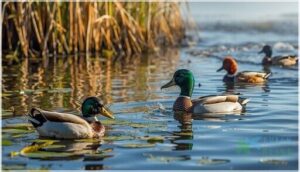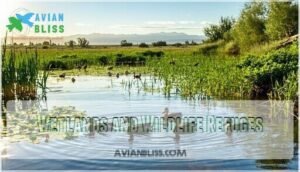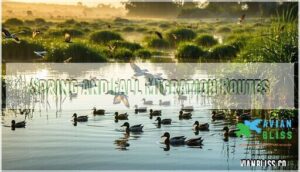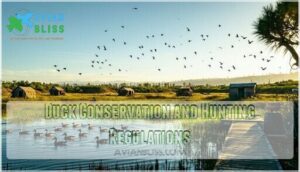This site is supported by our readers. We may earn a commission, at no cost to you, if you purchase through links.

The Pacific Flyway brings seasonal visitors, while year-round residents stick around thanks to restored wetlands spanning over a million acres. Whether you’re watching from San Francisco Bay’s salt marshes or Central Valley rice fields, you’ll spot everything from speedy northern pintails to subtle gray gadwalls.
The real magic happens when you know exactly where and when to look.
Table Of Contents
- Key Takeaways
- Popular Duck Species in California
- Where to Spot Ducks in California
- Duck Migration and Breeding Patterns
- What California Ducks Eat
- Duck Conservation and Hunting Regulations
- Frequently Asked Questions (FAQs)
- What is the most common duck in California?
- How many types of ducks are there in California?
- Are wood ducks common in California?
- Where to find ducks in California?
- What kind of duck is in California?
- Do California ducks migrate?
- What do California ducks eat?
- Where do California ducks go in the winter?
- How do California ducks protect themselves from predators?
- What are the main threats to California duck populations?
- Conclusion
Key Takeaways
- You’ll find over 40 duck species across California’s diverse habitats, from dabbling ducks like mallards in shallow wetlands to diving species like canvasbacks in deeper waters and sea ducks along the coast.
- California’s wetlands serve as a major stop on the Pacific Flyway, hosting millions of migrating ducks each fall and winter, with peak populations occurring from November through February in places like the Central Valley.
- You can spot ducks at premier locations including Sacramento National Wildlife Refuge, San Francisco Bay salt marshes, Central Valley rice fields, and coastal areas—each habitat supporting different duck species with unique feeding behaviors.
- Duck populations face significant conservation challenges from habitat loss (95% of historic Central Valley wetlands are gone), drought, and climate change, making wetland restoration efforts and hunting regulations crucial for their survival.
Popular Duck Species in California
You’ll find three main duck groups across California’s diverse wetlands, each with distinct characteristics and behaviors.
Dabbling ducks like mallards and teals feed at the surface, diving ducks such as canvasbacks plunge underwater for food, and sea ducks including mergansers prefer coastal waters.
Dabbling Ducks (Mallard, Gadwall, Teal)
Dabbling ducks are the shallow-water specialists you’ll encounter most often in California. These surface feeders tip forward to reach underwater plants, creating that classic "bottoms-up" pose.
Watch these skilled hunters tip forward in shallow waters, their tails pointing skyward as they forage beneath the surface
Their foraging techniques and habitat preferences make them conservation success stories across wetlands statewide.
- Mallards – vibrant green heads make males instantly recognizable
- Gadwalls – subtle gray patterns create understated elegance
- Cinnamon Teals – bright rusty plumage stands out dramatically
- Blue-winged Teals – distinctive wing patches flash during flight
Diving Ducks (Canvasback, Bufflehead, Ruddy Duck)
What makes diving ducks special? Unlike dabbling ducks, these California species possess remarkable diving adaptations for underwater foraging.
Canvasbacks showcase elegant aerodynamic bodies and sloped profiles perfect for duck identification. Buffleheads display compact builds with striking black-and-white patterns. Ruddy ducks feature stout necks and upright tails.
These duck species face conservation challenges from habitat loss, impacting population trends across California ducks and duck hunting opportunities.
Sea Ducks (Scoters, Mergansers)
Why venture into saltwater when freshwater ducks seem easier to spot? California’s sea ducks thrive in coastal habitats where saltwater adaptations help them excel.
Surf Scoter identification becomes simple once you notice males’ colorful bills. Black Scoter and White-winged Scoter join coastal flocks during winter. Common Merganser and Red-breasted Merganser showcase different merganser diets—fish-focused feeding that requires specialized bills.
These species face conservation challenges from habitat loss and pollution. The Surf Scoter, scientifically known as Melanitta perspicillata, is a fascinating sea duck.
Migratory Vs. Resident Ducks
California hosts both Migratory Ducks and Year-Round Residents, creating varied Population Dynamics. Migration Triggers like temperature and daylight drive seasonal movements, while residents adapt to local Habitat Differences.
Migratory species face greater Conservation Needs due to habitat loss along flyways. Breeding, Nesting, and Feeding patterns vary substantially between groups, requiring targeted Habitat Conservation strategies for each population type.
Where to Spot Ducks in California
You’ll find California’s ducks in diverse habitats across the state, from coastal wetlands and mountain lakes to urban ponds and wildlife refuges.
The best spots include San Francisco Bay’s salt marshes, Central Valley’s rice fields, and protected areas like the Sacramento National Wildlife Refuge Complex.
Wetlands and Wildlife Refuges
Looking for waterfowl hotspots? You’ll find prime duck-watching at Sacramento National Wildlife Refuge and San Luis National Wildlife Refuge, where Refuge Management maintains superior Water Quality.
Gray Lodge Wildlife Area and Bolsa Chica Ecological Reserve showcase successful Habitat Restoration efforts.
Central Valley Wetlands face Climate Impacts and Invasive Species challenges, but dedicated conservation work keeps these areas thriving for diverse duck populations year-round.
Consider visiting Point Reyes National Seashore for shorebird viewing.
Rivers, Lakes, and Ponds
Freshwater habitats across California offer prime duck viewing opportunities. You’ll find diverse species adapting to varying water quality conditions, though habitat degradation and invasive species pose ongoing challenges.
Top freshwater duck viewing sites:
- Lake Tahoe – Crystal-clear waters attract diving ducks year-round
- Sacramento River Delta – Massive wetland system supporting migratory flocks
- Mono Lake – Alkaline waters teem with unique duck species
- Clear Lake – Northern California’s largest natural lake hosts wintering waterfowl
- Salton Sea – Inland sea supporting thousands of migrating ducks
Human impact affects these ecosystems, making wetland conservation essential for maintaining healthy duck populations at these wildlife refuges.
Coastal and Shoreline Areas
Along California’s stunning coastline, diving ducks like scoters and mergansers thrive in saltwater habitats despite challenges from coastal erosion and pollution impacts. These duck viewing sites offer excellent opportunities to spot sea ducks near wetlands where conservation strategies protect essential breeding grounds from habitat loss and saltwater intrusion.
You can find California sea duck products online.
National Parks and Protected Lands
Beyond the typical wetlands, California’s National Parks offer outstanding duck-watching opportunities. You’ll find diverse waterfowl in Yosemite’s alpine lakes and Death Valley’s desert oases.
Protected Area Diversity means species like mergansers thrive in park environments where Habitat Conservation protects critical breeding grounds. These National Monument Ducks benefit from Conservation Efforts that maintain unspoiled Park Duck Habitats, making Wetland Conservation a cornerstone of Refuge Conservation Impact and Habitat Restoration Success.
Duck Migration and Breeding Patterns
You’ll witness California’s remarkable duck migrations as millions of birds travel the Pacific Flyway each spring and fall, turning the state’s wetlands into bustling avian highways.
These seasonal movements connect with complex breeding cycles, where different species choose everything from dense marsh vegetation to tree cavities for nesting sites.
Spring and Fall Migration Routes
California’s migratory ducks follow the Pacific Flyway during Migration Timing from September through November. These ducks travel thousands of miles with Route Variations depending on weather patterns and wetlands availability.
Climate Impacts affect traditional routes, forcing waterfowl hunting zones to adapt.
Habitat Connectivity through California’s Central Valley provides essential Stopover Ecology sites for rest and feeding during their epic journeys.
Breeding and Nesting Habits
Duck breeding season brings fascinating nesting behaviors you’ll notice across California’s wetlands. Different species show varied nest site selection, from mallards choosing ground vegetation to wood ducks preferring tree cavities.
Clutch size variation ranges from 4-15 eggs depending on species. Incubation periods last 21-35 days, with females providing dedicated parental care.
Breeding plumage becomes vibrant during mating displays, helping attract mates and promote duckling survival rates. To support successful nesting, consider providing specialized nesting structures.
Wintering Grounds in California
Every winter, California’s Central Valley becomes a waterfowl paradise, hosting nearly six million ducks seeking warmer climate and abundant food sources. The Sacramento Valley alone welcomes 1.9 million ducks, while Yolo-Delta accommodates another million. These wetlands provide vital habitat availability despite conservation challenges from development.
Migration patterns bring northern pintails, shovelers, and wigeons to flooded rice fields and managed refuges. Waterfowl hunting zones reflect this concentration, with peak populations occurring from November through February across California’s remaining wetland corridors.
The Yolo Bypass Wildlife Area is a key managed wetland providing habitat.
What California Ducks Eat
You’ll discover that California ducks have surprisingly varied diets that change with the seasons and their species type. Dabbling ducks like mallards feed on aquatic plants and seeds in shallow water, while diving ducks such as canvasbacks hunt for fish and crustaceans in deeper areas.
Aquatic Plants and Seeds
When you spot ducks feeding in California’s wetlands, they’re likely munching on nature’s buffet of aquatic plants and seeds. These plant materials provide essential nutritional value and support diet diversity across species. Dabbling ducks particularly rely on this vegetation for energy and nutrients.
- Pondweed seeds floating on water surfaces like tiny green pearls
- Bulrush stems swaying underwater, offering crunchy texture
- Wild rice grains scattered across shallow marshes
- Sedge roots providing fiber-rich sustenance below the surface
- Algae coating rocks like nature’s vitamin supplement
Plant abundance directly influences duck populations and habitat structure. This vegetation facilitates seed dispersal throughout wetland ecosystems. Feeding habits vary between dabbling ducks and diving ducks, but both depend on healthy plant communities. Wetland conservation efforts focus on maintaining these vital food sources for sustainable duck populations.
Insects, Crustaceans, and Fish
Beyond plant matter, you’ll find diving ducks and dabbling ducks have quite different feeding habits in terms of protein. Duck species that dive underwater excel at catching fish, while surface feeders focus on aquatic invertebrates and insect larvae. These protein sources play a vital role in the food web.
Fish consumption varies dramatically among species, with mergansers being specialized fish-eaters.
Seasonal Changes in Diet
California’s ducks shift their feeding habits dramatically throughout the year. You’ll notice dabbling ducks adapting to what’s available as seasons change. During breeding season, protein-rich insects become essential for successful reproduction. Bird diets vary considerably based on species and food availability.
- Spring Breeding Diets: High-protein insects and invertebrates fuel egg production
- Summer Insect Abundance: Peak foraging on aquatic larvae and crustaceans
- Fall Seed Consumption: Migration diet shifts toward energy-rich seeds and grains
Winter food scarcity forces ducks to rely heavily on stored plant materials and whatever aquatic vegetation remains accessible beneath ice.
Duck Conservation and Hunting Regulations
You’ll need to understand California’s hunting laws if you plan to hunt ducks, which requires specific licenses and follows strict seasonal limits set by the Department of Fish and Wildlife.
Conservation efforts have restored over 1 million acres of wetlands statewide, though California’s duck populations still face challenges from habitat loss and declining numbers.
Wetland and Habitat Conservation Efforts
Protecting duck populations requires thorough habitat conservation strategies. California’s wetlands face threats from development and climate impacts, making restoration work essential.
Organizations like Ducks Unlimited lead habitat restoration projects, restoring over one million acres statewide. Conservation funding aids pollution reduction efforts and community engagement programs.
You can participate through volunteer restoration events and supporting wetland conservation initiatives that protect these precious ecosystems for future generations.
Waterfowl Hunting Laws and Licenses
Before you grab your gear and hit the wetlands, you need proper documentation for Legal Hunting. Waterfowl Hunting Regulations require specific License Requirements to keep you within the law. Habitat loss endangers many duck species.
- Hunting License – All hunters must carry a valid California hunting license
- California Duck Validation – Required unless hunting with a Junior Hunting License
- Federal Duck Stamp – Mandatory for hunters 16 and older
- HIP Validation – Harvest Information Program registration for waterfowl species
Hunting Seasons and Bag Limits
When planning your waterfowl hunting adventure, Zone Regulations dictate different Hunting Seasons and Limits across California.
Your Hunting License and California Duck Validation guarantee Legal Hunting, while Species Restrictions control Bag Possession Limits.
These Waterfowl Hunting Regulations include License Requirements and specific Validation Details that vary by zone and species.
Community Involvement and Restoration Projects
Beyond traditional Conservation Efforts, you can directly support duck populations through hands-on involvement. Community Partnerships between CDFW and local groups create meaningful Volunteer Opportunities for wetland restoration and Citizen Science projects. Educational Programs teach sustainable practices while Public Hunting Areas benefit from community stewardship. These efforts can be enhanced by specialized habitat products.
- Join local Wetland Restoration projects to remove invasive plants
- Participate in duck population surveys as Citizen Science volunteers
- Support Educational Programs at wildlife refuges and visitor centers
- Volunteer at Public Hunting Areas for habitat maintenance activities
Frequently Asked Questions (FAQs)
What is the most common duck in California?
You’ll spot Mallards everywhere in California – they’re definitely the most common species here. These adaptable ducks with vibrant green heads thrive in any wetland habitat and feel comfortable around people, making them California’s most widespread waterfowl species.
How many types of ducks are there in California?
You’ll find approximately 20-30 duck species in California, depending on the season. About twenty species are common in Central Valley freshwater marshes during winter, while other sources identify 22-30 different types throughout the state.
Are wood ducks common in California?
Wood ducks aren’t super common in California, but you’ll find them in riparian areas, forested wetlands, and freshwater marshes. Conservation efforts have helped stabilize their populations across the state.
Where to find ducks in California?
Though you might think untouched locations are hard to reach, you’ll find ducks at Sacramento National Wildlife Refuge, Central Valley wetlands, San Pablo Bay, and Salton Sea easily.
What kind of duck is in California?
You’ll encounter mallards with green heads, gadwalls with gray patterns, cinnamon teals with bright red plumage, American wigeons with green eye patches, and blue-winged teals with distinctive wing markings.
Do California ducks migrate?
California’s 2024 breeding duck population dropped 25% to 373,864 birds. Yes, you’ll see many ducks migrate through California seasonally. They follow ancient flyways, seeking warmer climates and abundant food sources during winter months.
What do California ducks eat?
You’ll find ducks munching on diverse diets. They eat aquatic plants, seeds, invertebrates, and fish. Mallards dabble for vegetation while mergansers dive deep for fish prey.
Where do California ducks go in the winter?
When winter arrives, you’ll find many duck species don’t actually leave the state at all. **Instead, ducks from colder regions migrate south into your wetlands and refuges.
**
Some stay year-round as permanent residents throughout the Central Valley.
How do California ducks protect themselves from predators?
Like tiny ninjas in feather suits, you’ll see ducks use clever tactics: natural coloration helps them blend into surroundings , while group vigilance lets them spot predators quickly and escape together.
What are the main threats to California duck populations?
You’ll face massive habitat loss as your biggest threat. Over 95% of historic Central Valley wetlands have vanished due to agriculture and development.
Drought conditions, pollution, and climate change compound these challenges, reducing breeding success rates substantially.
Conclusion
**California’s wetlands unfold like nature’s theater, where every ripple tells a story.
**
You’ve now discovered the fantastic diversity of California ducks, from graceful mallards to diving canvasbacks. Whether you’re exploring San Francisco Bay or Central Valley refuges, these outstanding waterfowl await your observation.
Remember to respect their habitats and follow conservation guidelines. Your next adventure spotting California ducks promises unforgettable encounters with these feathered residents and seasonal visitors.
- https://avibirds.com/ducks-in-california/
- https://www.ducks.org/newsroom/press-release/2024-california-waterfowl-survey
- https://duckscdn.blob.core.windows.net/imagescontainer/landing-pages/conservation/initiatives/CAWetlands.pdf
- https://www.westsideconnect.com/news/community-news/ducks-unlimited-expands-conservation-efforts-with-new-gustine-chapter/
- https://www.outdoorlife.com/conservation/can-hunting-survive-in-california/












